After finishing this edition’s tour of Texas wineries, I have headed to France for the summer to lead cycling trips with an active touring company. Luckily and blissfully, this assignment starts in Provence and the Southern Rhône where we travel through Gigondas, Vacqueyras, and Beames-de-Venise, as well as lesser known Rhône Villages and parts of Ventoux.
I won’t write much about France in this venue because this blog is about Texas and the people we meet with the book, but I would like to take note of my first visit to the wineries in the region and here’s why: they are not so different from Texas. In fact, it was drinking wine at tasting rooms in Texas that helped me understand what is happening here, more so even than if I had spent this time in Napa Valley, or maybe anywhere else in the United States. The more I learn, the more I believe Texas is, quite simply, more like Europe than anywhere else in the country (and for many more reasons than just the varieties grown).
The steward of the first tasting room I entered in Gigondas sorted through my strangely accented French to offer an English interaction, which was fortunate because his bi-lingual wine terminology was much better than mine. I asked a lot of questions, similar to ones I ask when meeting with Texas wine makers and grape growers, and he was just as eager to talk about it as anyone.
I was shown maps of microclimates, given explanations of terroir and blending techniques across different vineyards, enlightened on different vine training techniques that echoed what I learned at home. For example, here in the Rhône, Mouvedre is head-trained (a Roman technique where vines are taught to grow upward with no wires, so that they look like goblets) because its cordons naturally reaches toward the sky and because the technique produces better fruit… just like Tannat, also head-trained by Bending Branch Winery.

John Rivenburgh explains head trained Tannat vines and Bending Branch Winery in Comfort, Texas
The education I received from wise Texas wine folk like Bobby Cox helped me understand why blending grapes from various microclimates adds layers of complexity to a wine. And pioneers like Les Constable at Brushy Creek Vineyards and Winery helped me understand why setting up a vine library is a good start to a vineyard, or even something to maintain for the entire life of someone’s estate.
And when the wine steward and I got more comfortable, he tested me on a white blend in which I identified 2 of the three grapes (Viognier and Roussane, missing Grenache Blanc) because these grapes are little rockstars in our state and I have tasted very true renderings of their character by our own wine makers.
I am not saying this to brag on myself. Anyone could do this. I am saying this to point out something marvelous about Texas tasting rooms: they are educational venues, opening visitors to world wines. As the pioneering minds of the Texas wine industry are broadening their plantings past the big California three (Merlot, Cabernet and Chardonnay) and honing in on what this climate and soil can best support, we are being exposed to a vast array of varieties somewhat novel to the American palate, and pronunciation: Tempranillo (think Spanish- does not rhyme with armadillo), Mourvedre, Tinta Cao, Carignane, Cinsault, Vermentino, Albariño, Aliagnico, Dolcetto, etc. They are beginning to increase in popularity and notoriety because they grow well here and show beautifully from our soil. And because of this happy trend, Texas tasting rooms are putting them into people’s mouths, both to drink and to say. This, I believe, is educating our visitors to a much wider world of taste and understanding, tapping Texas wine tourists into a global market, in a way I don’t think even most of California can do.
At the end of my lovely visit with this Gigondas winery, I explained that I was from Texas and interested in wine there, too. The steward said he had actually met several Texans who visited his tasting room, and that they knew quite a bit about the Gigondas varieties. Perhaps they studied on their own, but I like to think they had exposure to local renditions as well, and took that knowledge abroad to explore the grapes further.
So my challenge to you, good drinker, is to visit a local winery or two and go for the grape variety you’ve never heard of, then ask your wine stewardess a little about its background. It’ll take you on a journey around the world through your taste buds. I think you’ll be delighted at how much there is to learn here at home.
Margaret Shugart






what a nice compliment to the Texas wine industry!
What a wonderful experience. Thanks for sharing this story. Wine is the great uniter across continents.
Pingback: Tannat in Texas vs. the World | The Wine Roads of Texas